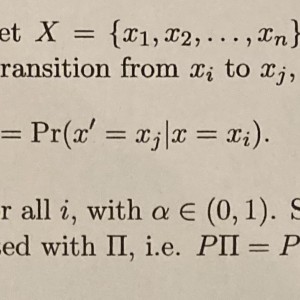Markov Process Problem
Any help is greatly appreciated. I'm completely lost.
Answer
We know that $P=P \Pi $. Also note that $P$ is a $1\times n$ matrix aka a row vector. So the k-th component of $P$ is $P$ times the k-th column of $\Pi$ :
$$ p_k =\sum _{i=1}^n p_i \pi _{ik} = \sum _{i=1}^n p_i \alpha = \alpha \sum _{i=1}^n p_i =\alpha 1=\alpha $$ since $P$ is a probability distribution and the sum of its components is one.
The interpretation is that if the probability of reaching the state $x_k$ from any state is the constant $\alpha$, then in the stationery distribution, which is the same as the probability distribution in the long run, the probability of being in the state $x_k$ is also $\alpha$.
 Martin
Martin
1.7K
The answer is accepted.
Join Matchmaticians Affiliate Marketing
Program to earn up to a 50% commission on every question that your affiliated users ask or answer.
- answered
- 1428 views
- $24.00
Related Questions
- Why does this spatial discretization with n intervals have a position of (n-1)/n for each interval?
- Problem Help - Matrix/Markov
- Discrete Math- Number of factor trees of a graph
- Order Notation
- Determine formula to calculate the radii of a unique ellipsoid from coordinates of non-coplanar locii on its surface, and without knowing its center or rotation angles.
- Logic Question (𝐴→(𝐵→𝐶))→((𝐴→𝐵)→(𝐴→𝐶))
- Logic Question 𝐴→(𝐵→𝐶),𝐴→𝐵,𝐴⊢𝐶
- Logic Question 𝐴∧(𝐵∨𝐶)⊢(𝐴∧𝐵)∨(𝐴∧𝐶)

